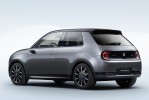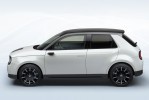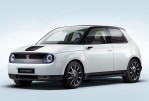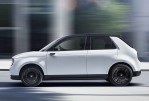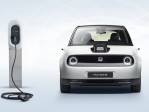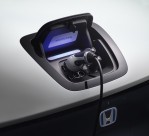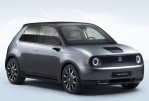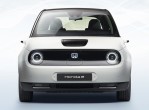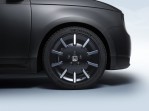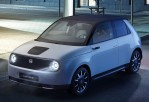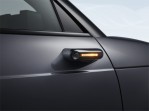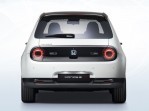Body style: Hatchback
Segment: Small
Production years: 2020, 2021, 2022, 2023, 2024
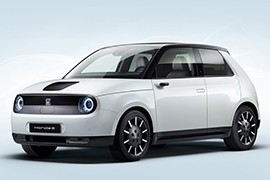 21 Photos
21 PhotosHonda introduced its first full-electric car on the market in 2020, following a concept that was unveiled by the Japanese automaker in 2017 at the Frankfurt Motor Show.
The Japanese automaker was not on its first eco-friendly vehicle. Previously, it had the first-generation of the Insight in 1999, followed by other products such as the Civic Hybrid or the CR-V hybrid. But the e was the first fully electric one, but unfortunately, customers didn't share the carmaker's vision. In addition, the world pandemic and the microchip crisis led to very slow sales.
On the outside, the design team tried to re-imagine the look of the first generation of the Civic. The e's round headlights that flanked the black panel between them and the minimalist exterior styling confirmed that. At the front, placed on the hood, the automaker installed the charging port, contradicting most other EVs on the market that had that installed on the rear quarter panels. One noticeable detail was the absence of the door mirrors, which were replaced by tiny rearview cameras. From its profile, the two-door hatchback sported a generous glass area, while at the back, the raked-forward C-pillars and tailgate ended the vehicle in a similar way as the 1972 Civic.
Inside, the front seats provided ample room for two occupants, while those seated in the back had to deal with a much smaller place, suitable mostly for children. The completely digital dashboard featured a set of displays covered under the same glass cover, creating the illusion of a widescreen. Apart from that, two additional six-inch screens that showed the images from the rearview cameras were mounted on the outer edges of the dash panel.
Honda offered the e with an electric motor available in two power versions: 100 kW and 113 kW (134 hp and 152 hp) that moved the rear wheels. The battery pack provided enough electricity for up to 225 km (140 miles).
HONDA e 2020, 2021, 2022, 2023, 2024
- 35.4 KWh (154 HP)
HONDA e
35.4 KWh (154 HP)
ENGINE SPECS - 35.4 KWh (154 HP) | |
|---|---|
| Power: | 113.3 KW @ - RPM 154 HP @ - RPM 152 BHP @ - RPM |
| Torque: | 232 lb-ft @ - RPM 315 Nm @ - RPM |
| Fuel System: | Electric |
| Fuel: | Electric |
PERFORMANCE SPECS | |
|---|---|
| Top Speed: | 93 mph (150 km/h) |
| Acceleration 0-62 Mph (0-100 kph): | 8 s |
TRANSMISSION SPECS | |
|---|---|
| Drive Type: | Front Wheel Drive |
| Gearbox: | 1-Speed automatic |
BRAKES SPECS | |
|---|---|
| Front: | Ventilated Discs |
| Rear: | Ventilated Discs |
TIRES SPECS | |
|---|---|
| Tire Size: | 185/60 R16 |
DIMENSIONS | |
|---|---|
| Length: | 153.3 in (3894 mm) |
| Width: | 68.9 in (1750 mm) |
| Height: | 58.9 in (1496 mm) |
| Front/rear Track: | 59.8/59.7 in (1,519/1,516 mm) |
| Wheelbase: | 98.4 in (2499 mm) |
| Cargo Volume: | 6 cuFT (170 L) |
WEIGHT SPECS | |
|---|---|
| Unladen Weight: | 3086 lbs (1400 kg) |
POWER SYSTEM SPECS | |
|---|---|
| Nominal Capacity: | 35.5 kWh |
| Maximum Capacity: | 35.5 kWh |
| Charging time (normal): | 3.3 hours |
| Range: | 140 miles (225.3 km) |
| Notes |
|---|
| Vehicle Consumption: 16.0 kWh/100km Charge Port: Type 2 Charge Power: 11 kW AC Charge Speed: 58 km/h Fastcharge Power (max): 50 kW DC Fastcharge Time (20->160 km): 31 min |



